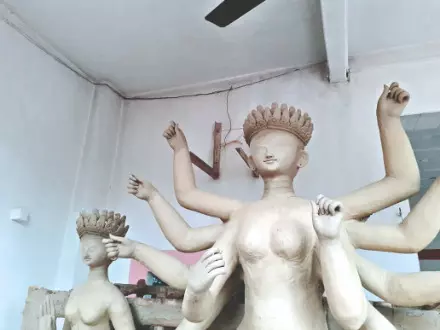Harishchandrapur: Heritage and freedom fight mark 300-year-old Puja

Malda: September marks not only the festive season but also a reminder of Malda’s deep-rooted ties with India’s freedom struggle. Harishchandrapur’s Pipla village, once a vibrant centre of the Independence movement, continues to draw attention for the legacy of freedom fighter Subodh Kumar Mishra and his family’s Durga Puja, known locally as the Boro Chali’r Durga. For over 300 years, this Puja has been celebrated with traditional rituals, symbolising a rare blend of heritage, faith and history.
Subodh Kumar Mishra, who once lit the torch of non-violent satyagraha in the district, traced his lineage to the disciples of Sri Chaitanya Mahaprabhu. His ancestors settled in Abhaypur during the early 16th century, where they embraced Vaishnavism under the influence of Chaitanya. Later, in the 18th century, Jagmohan Mishra moved to Harishchandrapur after acquiring land from a local zamindar and his son Abhayprasar Mishra began the Durga Puja at Sultanagar. Eventually, after devastating floods, the family relocated the deity’s shrine to Pipla, where the worship of Durga, Kali, and Chandi continues in the form of Trishakti Aradhana.
Speaking about the continuity of tradition, veteran family member Samar Kumar Mishra said: “Our ancestors safeguarded this Puja even in the face of calamities. The rituals, the single-frame idol and the large backdrop paintings have remained unchanged for centuries.”
One of the striking aspects of the Puja is the practice of animal sacrifice, still preserved according to age-old customs. Renowned dancer and family member Surajit Mishra explained: “On Saptami, a goat is sacrificed at the time of the goddess’s eye-opening ceremony. Similar offerings are made during Ashtami, Sandhipuja and Nabami. Even the wooden platform used for sacrifices is more than a hundred years old.”
The family recalls how during the Bengal famine of the 1940s, when villages around were devastated, the deity seemed to protect them. Tapobrata Mishra added: “Our elders often said it was Maa Durga who shielded us during those dark times. That is why, even today, we continue Narayan Seva and distribute clothes on Dashami.”
Despite many members living outside Bengal, the Puja remains a unifying force. Professor Tanuj Mishra, now engaged in research in another state, noted: “The doors remain open for everyone. Villagers and family members return home during the Puja, reaffirming their faith and heritage.”
For the local community, the Puja is not just an annual festival but a living history of sacrifice and devotion. Villager Parimal Das summed it up: “We believe Maa Durga has always stood by us. This tradition, linked with freedom and faith, is our pride.”



